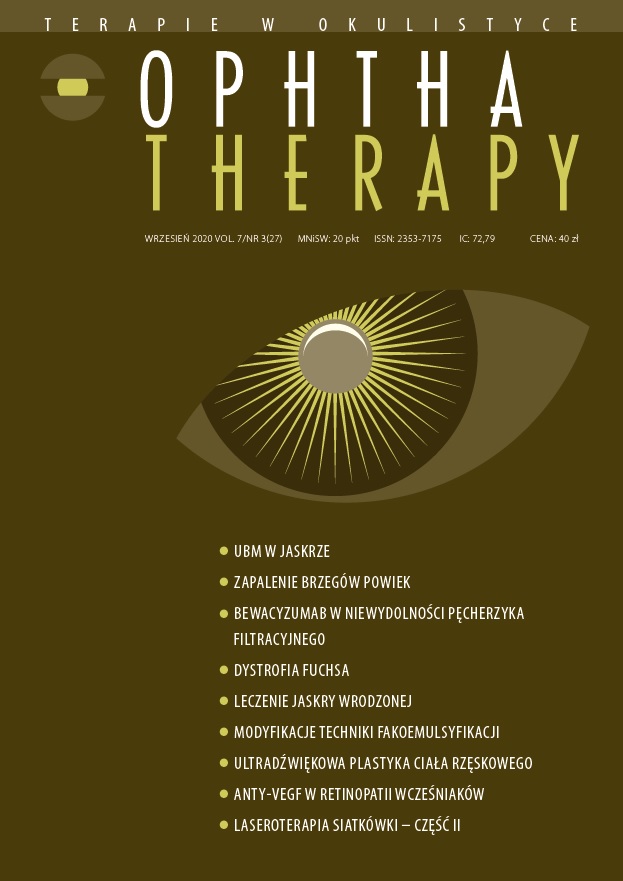The role of social media in ophthalmology: a narrative review
Main Article Content
Abstract
Social media have played an increasing role in medicine with potential applications for both physicians and patients. This trend has also impacted clinical and surgical practice in ophthalmology in a wide range of subspecialties to promote scientific research findings, provide further tools for teaching, and ease communication between ophthalmologists across the globe improving patient care. However, social media have certain limitations that need to be overcome to ensure their reliability and quality for physicians and patients. This article provides a review of the current applications and pitfalls of social media in ophthalmology.
Downloads
Article Details

This work is licensed under a Creative Commons Attribution-NonCommercial-NoDerivatives 4.0 International License.
Copyright: ? Medical Education sp. z o.o. License allowing third parties to copy and redistribute the material in any medium or format and to remix, transform, and build upon the material, provided the original work is properly cited and states its license.
Address reprint requests to: Medical Education, Marcin Kuźma (marcin.kuzma@mededu.pl)
References
2. Barreto JE, Whitehair CL. Social Media and Web Presence for Patients and Professionals: Evolving Trends and Implications for Practice. PM R. 2017; 9(5S): S98-S105. https://doi.org/10.1016/j.pmrj.2017.02.012.
3. Latif MZ, Hussain I, Saeed R et al. Use of Smart Phones and Social Media in Medical Education: Trends, Advantages, Challenges and Barriers. Acta Inform Med. 2019; 27(2): 133-8. https://doi.org/10.5455/aim.2019.27.133-138.
4. Farag M, Bolton D, Lawrentschuk N. Use of YouTube as a Resource for Surgical Education-Clarity or Confusion. Eur Urol Focus. 2020; 6(3): 445-9. https://doi.org/10.1016/j.euf.2019.09.017.
5. Clarke C, Smith E, Khan M et al. Social Media and Ophthalmology: Perspectives of Patients and Ophthalmologists. J Med Syst. 2018; 42: 258.
6. Ward B, Ward M, Nicheporuck A et al. Assessment of YouTube as an Informative Resource on Facial Plastic Surgery Procedures. JAMA Facial Plast Surg. 2019; 21(1): 75-6. https://doi.org/10.1001/jamafacial.2018.0822.
7. Hogg H, Pereira M, Purdy J et al. A non-randomised trial of video and written educational adjuncts in undergraduate ophthalmology. BMC Med Educ. 2020; 20(1): 10. https://doi.org/10.1186/s12909-019-1923-1.
8. Rapp AK, Healy MG, Charlton ME et al. YouTube is the Most Frequently Used Educational Video Source for Surgical Preparation. J Surg Educ. 2016; 73(6): 1072-6. https://doi.org/10.1016/j.jsurg.2016.04.024.
9. McKee HD, Jhanji V. Learning DMEK From YouTube. Cornea. 2017; 36(12): 1477-9.
10. Tsui E. Ophthalmology on social networking sites: an observational study of Facebook, Twitter, and LinkedIn. Clin Ophthalmol. 2015: 285-90.
11. Christiansen SM, Oetting TA, D. Herz N. Twitter at the 2014 and 2015 Annual Meetings of the American Academy of Ophthalmology. 2016: 2015-7. https://doi.org/10.1016/j.ophtha.2016.03.012 .
12. Hayon S, Tripathi H, Stormont IM et al. Twitter Mentions and Academic Citations in the Urologic Literature. Urology. 2019; 123: 28-33. https://doi.org/10.1016/j.urology.2018.08.041 .
13. Gi N, Adio O. How ophthalmologists and ophthalmologists-in- training in Nigeria use the social media. Niger J Med. 2016; 25(3): 254-8.
14. Aleo CL, Hark L, Leiby B et al. Ophthalmic Patients' Utilization of Technology and Social Media: An Assessment to Improve Quality of Care. Telemed J E Health. 2014; 20(10): 887-92. https://doi.org/10.1089/tmj.2013.0365.
15. McGregor F, Somner JEA, Bourne RR et al. Social media use by patients with glaucoma: what can we learn? Ophthalmic Physiol Opt. 2014; 34: 46-52. https://doi.org/10.1111/opo.12093.
16. Li J, Huang W, Gao J et al. Impact of Mobile-Based Health Education on the Awareness and Knowledge of Glaucoma in Chinese Patients. Telemed J E Health. 2019; 25(6): 455-61. https://doi.org/10.1089/tmj.2018.0123.
17. Cameron AM, Massie AB, Montgomery RA et al. Social Media and Organ Donor Registration: The Facebook Effect. 2013: 2059-65. https://doi.org/10.1111/ajt.12312 .
18. Henderson ML, Adler JT, Van Pilsum Rasmussen SE et al. How Should Social Media Be Used in Transplantation? A Survey of the American Society of Transplant Surgeons. Transplantation. 2019; 103(3): 573-80. https://doi.org/10.1097/TP.0000000000002243.
19. Williams AM, Muir KW. Awareness and attitudes toward corneal donation: challenges and opportunities. Clin Ophthalmol. 2018; 12: 1049-59.
20. Musiimenta A, Sanguansak T, Morley KE et al. Two-Way Social Media Messaging in Postoperative Cataract Surgical Patients: Prospective Interventional Study. J Med Internet Res. 2017; 19(12): e413. https://doi.org/10.2196/jmir.8330.
21. Smith JR, Pe?er J, Belfort RN et al. Proceedings of the Association for Research in Vision and Ophthalmology and Champalimaud Foundation Ocular Oncogenesis and Oncology Conference. Transl Vis Sci Technol. 2018; 8(1): 9. https://doi.org/10.1167/tvst.8.1.9.
22. Tsui E, Rao RC, Carey AR et al. Using Social Media to Disseminate Ophthalmic Information during the #COVID19 Pandemic. Ophthalmol. 2020. https://doi.org/10.1016/j.ophtha.2020.05.048 [Epub ahead of print].
23. Shih KC, Chan JCH, Chen JY et al. Ophthalmic clinical skills teaching in the time of COVID-19: A crisis and opportunity. Med Educ. 2020. https://doi.org/10.1111/medu.14189 [Epub ahead of print].
24. Basanta Calderon I. https://bookpedia.co/es/libro/1514509569/webinars-oftalmologia (Access: 3.07.2020).
25. Decamp M, Koenig TW, Chisolm MS. Social Media and Physicians? Online Identity Crisis. JAMA. 2013; 310(6): 581-2. https://doi.org/10.1001/jama.2013.8238.
26. Boateng B, Holzinger A, Sheps S et al. Social Media: A Review and Tutorial of Applications in Medicine and Health Care. J Med Internet Res. 2014; 16(2): e13. https://doi.org/10.2196/jmir.2912.
27. Şahin A, Şahin M, Türkcü FM. YouTube as a source of information in retinopathy of prematurity. Ir J Med Sci. 2019; 188(2): 613-7. https://10.1007/s11845-018-1902-2.
28. Guthrie G, Davies RM, Fleming CK et al. YouTube as a source of information about retinitis pigmentosa. Eye (Lond). 2014; 28(4): 499-500. https://doi.org/10.1038/eye.2013.312.
29. Staffieri SE, Kearns LS, Sanfilippo PG et al. Crowd-sourced Ontology for Photoleukocoria: Identifying Common Internet Search Terms for a Potentially Important Pediatric Ophthalmic Sign. Transl Vis Sci Technol. 2018; 7(1): 18.
30. Chen AJ, Chan JJ. Retinal Implants: Analysis of the News Media Perspective. 2014; 132(1): 2013-4. https://doi.org/10.1001/jamaophthalmol.2013.5698.
31. Bae SS, Baxter S. YouTube videos in the English language as a patient education resource for cataract surgery. Int Ophthalmol. 2018; 38(5): 1941-5. https://doi.org/10.1007/s10792-017-0681-5.
32. Aykut A, Senel A, Bugra K et al. Everything is ok on YouTube! Quality assessment of YouTube videos on the topic of phacoemulsification in eyes with small pupil. Int Ophthalmol. 2019; 39: 385-91. https://doi.org/10.1007/s10792-018-0823-4.

